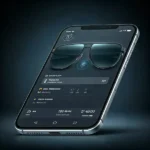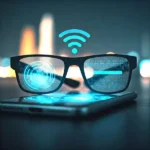Smart Glasses in Professional/Enterprise Cases
The adoption of smart glasses in enterprise is no longer a futuristic concept but a tangible reality, driven by advancements in Augmented Reality (AR), Artificial Intelligence (AI), and robust hardware. This section provides a more detailed look at their applications, backed by industry examples and the underlying technological prowess. Discover more about Smart Glasses for business and AR applications.
I. Enhanced Remote Assistance and Collaboration: Bridging Geographical Gaps
Expertise in Action: This is arguably one of the most mature and impactful use cases. Companies are leveraging smart glasses to virtually bring expert knowledge to the frontline, regardless of location.
- Real-world Example: BMW has successfully implemented smart glasses for after-sales service. Technicians on the ground can connect with remote Porsche specialists, who can see precisely what the technician sees through the smart glasses’ camera. The experts can then provide real-time guidance, annotate the technician’s view with digital instructions, and highlight specific areas for repair. This significantly reduces the need for expert travel, leading to faster resolution times (some repairs completed up to 75% faster) and substantial cost savings.
- Technological Underpinnings:
- High-Resolution Cameras: Crucial for transmitting clear, detailed video feeds to remote experts. Many professional-grade smart glasses offer 1080p 60fps video capabilities.
- Low-Latency Connectivity: Essential for real-time interaction. Enterprise solutions often rely on robust Wi-Fi (WLAN) or cellular connectivity (5G is emerging) to ensure minimal delay in video and audio transmission.
- Robust Audio Capabilities: Noise-canceling microphones (e.g., 100 dB noise cancellation in some RealWear models) are vital for clear communication in noisy industrial environments.
- AR Overlay Software: Allows remote experts to draw, point, and add text directly into the technician’s field of view, making instructions incredibly precise.
II. Revolutionizing Manufacturing and Assembly: The “Superpower” for Frontline Workers
Smart glasses for business are providing frontline manufacturing and assembly workers with “superpowers” by integrating digital information into their physical workflow.
- Real-world Example: Lockheed Martin utilizes smart glasses to guide technicians through the complex assembly of aerospace components. AR overlays provide step-by-step instructions, highlight specific parts, and even offer visual confirmations for correct placement. This approach has led to a significant reduction in errors and assembly times. Similarly, BMW’s Munich factory has seen improvements in inventory identification times by 22% and a 33% reduction in errors through smart glasses.
- Case Study (Quality Control): A study on industrial quality control highlighted the application of smart glasses for real-time quality inspection during assembly. By combining the smart glasses’ video feed with a server-based image recognition system (using advanced YOLOv8 model), immediate visual feedback and significantly enhanced defect detection in terms of both speed and accuracy were achieved. This demonstrates the power of integrating computer vision and AI with AR for quality assurance.
- Technological Underpinnings:
- Heads-up Displays (HUDs) / Micro-OLED / LCOS Displays: Provide clear, crisp overlays without obstructing the user’s view of the real world.
- Computer Vision and Object Recognition: AI algorithms embedded in the glasses or on a connected device can identify objects, track movements, and verify correct procedures.
- Intuitive User Interfaces: Voice control (Natural Language Processing – NLP) is increasingly common, allowing workers to navigate instructions and input data without using their hands.
III. Optimizing Logistics and Warehousing: Vision Picking and Beyond
The logistics sector has been an early and successful adopter of smart glasses for business, particularly for “vision picking” applications.
- Real-world Example: DHL was a pioneer in implementing smart glasses for vision picking in its warehouses, partnering with companies like Google, Ubimax, and Vuzix. A pilot program in 2014 showed an improvement in the picking process of up to 25%. By replacing traditional handheld scanners, productivity increased, error rates decreased, and employee satisfaction improved. More recently, Aptus Group equipped its teams with Vuzix M400 smart glasses, combining AR, AI, and machine vision, resulting in a 15% performance increase in receiving products, a 24% “put-away” performance increase, and a 20% faster picking and packing process.
- Impact on Efficiency: Studies indicate that smart glasses can convert “dead time” (e.g., looking down at a scanner or paper list) into “value-added time,” significantly enhancing order picking efficiency.
- Technological Underpinnings:
- Barcode and QR Code Scanning (Vision Picking): Workers can simply look at an item to scan its barcode or QR code, reducing the need for separate handheld scanners.
- Real-time Inventory Data Integration: Smart glasses connect to warehouse management systems to display picking lists, item locations, and stock levels directly in the worker’s view.
- Navigation and Pathfinding: GPS-like functionality for indoor environments helps workers navigate large warehouses efficiently.
IV. Transforming Healthcare: Precision, Training, and Telemedicine
Smart glasses for business are making significant inroads into healthcare, enhancing precision in critical procedures, revolutionizing medical training, and enabling advanced telemedicine.
- Real-world Examples:
- Surgical Assistance: Companies like Augmedics with their Xvision system allow surgeons to overlay 3D models of patient anatomy (from CT scans, for example) directly onto the surgical field, enhancing precision during complex operations like spinal or neurosurgery. This allows surgeons to maintain focus on the patient without looking away at separate screens.
- Medical Training: AR can create immersive training environments where medical students can explore 3D anatomical models, practice surgical procedures, and even engage in simulated emergency scenarios, accelerating skill development and knowledge retention.
- Remote Consultation and Telemedicine: In emergency situations or for remote clinics, AR glasses allow on-site practitioners to connect with specialists who can provide real-time guidance, annotate live video feeds, and assist with diagnostics or procedures. Taiwan’s Chi Mei Medical Center utilizes Vuzix M400 smart glasses in emergency rooms and for first responders to provide instant access to experts, reducing emergency response times and ensuring faster diagnoses.
- Vein Visualization: AR technology can project a map of veins onto the skin, making it easier for nurses and technicians to locate veins for blood draws or IV insertions, especially for patients with difficult-to-find veins.
- Technological Underpinnings:
- High-Precision Tracking: Essential for accurate overlay of medical imagery onto the patient.
- DICOM Image Integration: Ability to display medical imaging data (CT, MRI) in a holographic format.
- Sterilizable Designs: Crucial for use in clinical and surgical environments.
- Secure Data Transmission: Ensuring patient privacy and compliance with regulations like HIPAA.
V. Design, Prototyping, and Field Service: Accelerated Innovation and Troubleshooting
Smart glasses in enterprise are streamlining product development and maintenance in the field.
- Real-world Example (Design): Ford Motor Company has used smart glasses to create virtual prototypes of vehicles. This allows engineers and designers to visualize 3D models in real-time, identify potential design flaws, and iterate quickly without the high cost and time of building physical prototypes.
- Real-world Example (Field Service): KPN, a European telecommunications service provider, equips its technicians with AR smart glasses to access a product’s service history and real-time location-based information dashboards. This has led to an 11% reduction in overall costs and a 17% drop in work-error rates. TotalEnergies leveraged RealWear HMT-1Z1 headsets with Microsoft Teams for refinery equipment maintenance, providing hands-free access to schematics and live communication with experts, reducing downtime and operational costs.
- Technological Underpinnings:
- 3D Model Rendering: High-performance processing to render complex 3D models in real-time.
- GPS and Indoor Positioning Systems: For precise location-based information in the field.
- Integration with Enterprise Resource Planning (ERP) and Customer Relationship Management (CRM) Systems: To pull relevant data for technicians.
Challenges and Future Outlook
While the benefits are clear, the adoption of smart glasses in enterprise also faces challenges that experts are actively addressing:
- Cost: Enterprise-grade smart glasses can be expensive, requiring a clear ROI justification.
- Battery Life: Extended use requires robust battery life or hot-swappable battery solutions.
- Comfort and Ergonomics: Especially for extended wear in industrial settings, comfort is paramount.
- Data Security and Privacy: Handling sensitive enterprise data and ensuring privacy (e.g., regarding built-in cameras) is a critical concern.
- Integration with Existing Systems: Seamless integration with legacy enterprise software and workflows is crucial for widespread adoption.
- Employee Acceptance: Addressing potential concerns about privacy, comfort, and the learning curve for new technology.
Despite these challenges, the market for smart glasses in enterprise is experiencing significant growth, with strong growth rates predicted for the coming years. Innovations in display technologies (Micro-OLED, LCOS), the increasing role of AI (NLP, computer vision), improved computing power and energy efficiency, and more sophisticated software platforms are continually enhancing the capabilities and feasibility of smart glasses for professional use. As the technology matures and becomes more affordable, smart glasses are poised to become an indispensable tool across a vast array of industries, empowering the workforce and driving unprecedented levels of efficiency and innovation.
Additional helpful information
Smart Glasses in the future is worth waiting for – The Future of Smart Glasses – What is coming?




